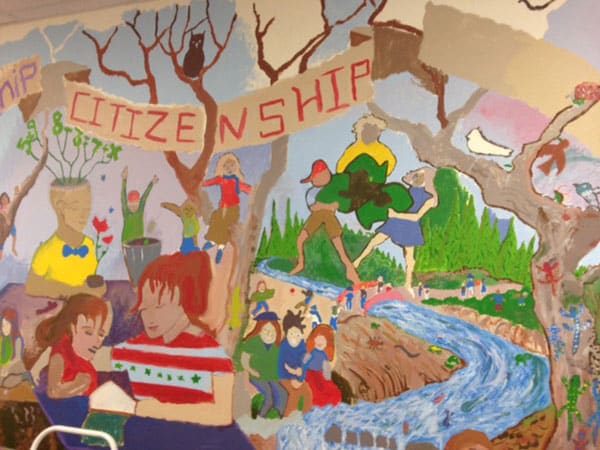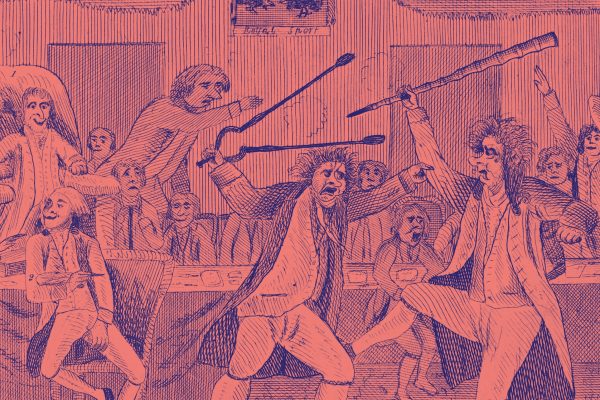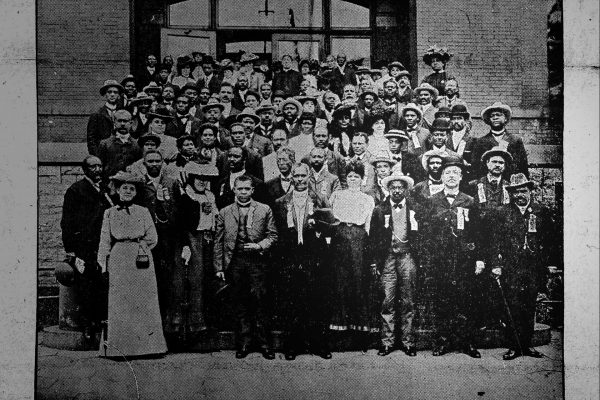This conversation is the seventh in the series Trench Democracy: Participatory Innovation in Unlikely Places. Innovative democratic professionals are recreating some of our most fundamental institutions, shaping new democratic practices and struggling against the sometimes profoundly counter-democratic tendencies of contemporary American institutions. While their work is always in progress, their experiences hold value for anyone interested in democracy’s future.
Vanessa Gray is the principal and co-founder of Forest Grove Community School, an independent public charter school located in a coastal agricultural town 25 miles West of Portland, Oregon. The school has a total of 200 students from first through eighth grades. Principal Gray and I talked recently about how democratic practice in her school and student voice there can make a difference in students’ lives. Before we begin, though, let’s put in our ear buds and listen to some classic rock.
Ironman
Osborne, let’s call him, was in the upper school at Forest Grove Community School and the last student one would expect to sign up for the yearly student-run talent show. He had more than enough to worry about at an age when young people are painfully aware of what their peers think of them. Osborne had significant mental and physical impairments. He was loud, sometimes spat when he talked, and moved in a jerky way. Even a casual observer would recognize that he had severe difficulties. But one day he announced that he wanted to sing Black Sabbath’s “Iron Man” for the talent show. So he did, he sang every verse and chorus, a cappella, to one of Heavy Metal’s most bombastic, monotonous, least inspired, and slowest-paced songs.
Has he lost his mind?Can he see or is he blind?Is he alive or dead?Has he thoughts within his head?
When he was finished the whole audience clapped and one of Osborne’s teachers from an earlier grade approached the school principal with tears in his eyes. “That was the most beautiful moment I have ever seen. I cannot believe that in an auditorium of over 200 kids I watched the faces of all these kids and did not see one kid who laughed or made fun or exchanged a look with another classmate. I think that is incredible.” Osborne himself was glowing, thrilled to have been able to perform in front of everyone.
Albert Dzur: Let’s start with a very basic question: why should schools be more democratic?
Vanessa Gray: We want adult citizens to be responsible community members and leaders. We do not think there is any way for people to grow up to be those kinds of adults if they do not have lots of practice doing it, so we want this as part of their education.
Students have social studies classes where they learn about the democratic system and these are, of course, important, but that is the knowledge and not the skills. There is a big difference between understanding something in theory and being able to participate in it. It is like knowing the rules and origin of a sport but never having played it. Without having these experiences of taking responsibility for their community, for others, for themselves, I do not see any way that we can expect them to be able to do it.
Take the issue of school rules. If responses to kids’ misbehaviors has only ever been detention, suspension, expulsion, without much else going on, then there is no real processing that happens, no understanding of their impact on other people and the entire community.Kids who come to our school late in their career will at first say things to me like, “Why do we have to talk about this?” Because really what they want is a detention.And I say, “Oh well, I do not believe that detentions actually help you learn anything. There are ways you can learn other than punishments, but I only know if you have learned them if you engage me in a conversation so that I understand where you are coming from, you understand where I am coming from, and we get to see more of the whole picture.”
Kids here will come to me and initiate concerns—things they want to talk about with me or have a conference about with other students. So they become accustomed and acculturated to having dialogue.
AD: Can you think of an example of something like that where a student initiates a conference?
VG: Earlier this year I had a student come and say that he wanted to meet with me because he was concerned about something he had heard. He was upset because his friend had told him a teacher at the school had been bad-mouthing a group of his friends.
So he and his friends came to me and we talked. I asked them, “What did you hear? Who did you hear it from? Do you think there could be a misunderstanding? Do you think that person heard it right? What do you think your teacher would have done or said? Does that make sense to you? Do you think we could have a conversation with your teacher?” So they all agreed that we would sit down with the teacher and talk about it.
We did talk and it was very helpful. I really appreciated that they had enough faith in us that we would be able to have conversations about this problem. I was impressed with their maturity.
AD: How does this connect to the idea of a democratic school?
VG: By the time kids have been here for a while they understand they have a voice in the school, they have valid perspectives that will be listened to, they can raise concerns, and they are entitled to answers. We encourage them to do that in lots of ways. We talk about having a culture of voice and choice. Choice has more to do with academic areas: making sure we are accommodating different students’ interests and preferences for expressing themselves, that sort of thing. But with voice, there are lots of ways that we raise students into this culture where it is an expectation.
First of all, we have classroom meetings where students have the opportunity to talk about things that concern them within their classroom or their level. We have all-school meetings once a month where the classes take turns and students stand up and present what they are learning. We have lots of student initiatives so when people have something they are interested in we encourage them to make announcements about it, have a bake sale, or do a talent show. We had a carnival here recently to raise money for leukemia. We help the students make those initiatives really work. We also have our eighth grade students do a capstone project where they learn about something they are passionate about but also give something back to the community as part of the process. These are the ways we say, “You have voice, you have agency, and we expect you to be doing these things.” Also, I will go into classrooms and talk to them about topics that interest them and encourage them to use their voice to ask me questions.
AD: So,if you are actually taking part in the school as an institution you are responsible for and which confronts you with problems you have to handle with other people, then as a kid you get valuable practical experience that will serve you as you encounter other institutions out in the community later on. But some kinds of service learning and civic education, by contrast, lack any real democratic meaning: students go through the motions without shaping or being responsible for their environment in any significant way.
VG: Right. We do have simulations here. At the moment students are learning about the thirteen colonies through an extensive experiential education project using simulations like being in the Continental Congress. This is great, but it is also very hypothetical and it feels almost as abstract as playing a board game. It helps them understand but it does not actually help them develop their citizenship muscles.
The academics may not be so much of a big difference between my school and another school, but the kids’ emotional intelligence is just so different. I have skeptics come up and ask, “Why would someone ever send their kid to your kind of school?” And so I have to think, “How can I put this so this person can understand?” My answer is that the children at this school are learning something really valuable because of the culture that we have.
AD: By “emotional intelligence,” do you mean a sense of responsibility and concern for others and the ability to take care of a public space?
VG: Yes, and there is another piece too. Part and parcel of our approach in making kids understand their place within the community and giving them opportunities to be active members is that they have to interact with all the other community members who have their own voices too. And when you do that, then you have conflict and you have to do some perspective-taking: you have to learn how to not just tolerate other people’s perspectives at a minimum but try to understand and appreciate them at a maximum. We see perspective-taking as a really important trait for civic leaders.
I was listening to kids in their classroom doing the Continental Congress and there is a kid in the class who is autistic. He is really high functioning, but one of his unique traits is that he is very rule bound. And he is not good with flexible thinking. He was in a group and they were arguing their different positions on this topic—there were loyalists and patriots. This group told me they really valued this student who has autism, I’ll call him Fred. “Yeah, Fred’s really good because he knows exactly what the rules are and he never forgets them! He remembers what the other group said in the last round of arguments!” And Fred is rigidly holding them to that: “Well, you said this!” So they really appreciated him.
They have grown up with this kid. He has been in this class for four years. And he can be a really big pain at times. He is who he is and they just accept him. They do not always enjoy him but they understand him. In most of our district’s schools class sizes are really large, and it is not possible for students’ voices to be heard unless you are one of those really strong voices. But when you have a community that is committed to student voice as a democratic school, you keep the class sizes small and you are always encouraging respect for other people’s perspectives. So I see that as another product of the way we do things: an appreciation for kids, for people, who are different.
AD: You have talked about two reasons for more democratic schools: improving community outside the school by getting kids ready to be more active citizens and increasing emotional intelligence by encouraging respect and appreciation for differences.
VG: There is another piece, too, which is for me as the boss of people in this school. I run this school as a participatory experience in terms of decision-making. We do not have a flat organization but we have put structures in place to facilitate collaboration and rely on us discussing, exploring, and coming to consensus as best we can. I just cannot imagine doing the job in another way; it is the only way everybody gets to be treated humanely.
I feel that way about the method of education, too. Democratic schools are just fundamentally humane and everybody gets to be treated like a valued human with unique perspectives and gifts. I cannot imagine treating people otherwise. It would be really uncomfortable to do things differently.
Not long ago I went to our local high school as part of a training event and we came in on the heels of a meeting between the high school principal and his staff. He was saying, “So then the doors will lock at 8:50. You are not to allow anyone into your classroom at that time and if they knock on the door you are not to allow them in. We will sweep the hallway and bring them to the office where they will be given their detention.” And I was thinking, “Oh my gosh this sounds just like prison.”
AD: That is a far cry from the revolutionary movement, speaking of the thirteen colonies and the Continental Congress.This is really where we have wound upsome 240 years later?
VG: Exactly. I understand why that system is in place in a school with 2,000 students. I guess I understand, anyway. But it is just so inhumane. On a smaller scale, there is this other elementary school in town where the kids who come into school late are stamped with a turtle because the turtle is slow. These kindergarteners, first graders, and second graders, they are not getting themselves to school; it’s their parents!
AD: Well that school obviously does not know its Aesop because the turtle wins at the end.
VG: Yes! So there are all these implicit and explicit ways that we send messages to kids about their worth.
AD: At Forest Grove Community School, you talk about three R’s of citizenship: “rigor,” “relevance,” and “relationships.” Can you tell me more about these?
VG: Part of our educational model is inspired by place-based learning and we do this because it provides relevance for students. Our educational model is reliant on community partners and we have relationships with these entities to provide content to students or to host our students as they go out into the community. We stress relationships throughout everything we do.
For example, recently we had a seventh grade student who punched another student. They were playing basketball and there were some tensions from inside the classroom getting played out in the game. Two kids were closely guarding, stealing the ball, and targeting this one kid and he got really mad and punched. So as I dealt with that, the victim’s dad approached me and wanted the boy who punched his child suspended. He was hell bent this would happen or he was going to call the police and charge the kid with assault. The kids themselves all understood each other’s perspective, so they were all okay. But what I really wanted to stress with everyone was that we have relationships with each other and we all have relationships to our community and so the way that we wanted to deal with this was to restore those relationships. That is just one example, but we are always talking about relationships.
AD: This example also seems to illustrate the importance of restorative justice in your school. You took a restorative approach to that problem.
VG: Here is what happened. There is a melee on the playground. So I pull a bunch of kids in and I talk with some credible witnesses, who agree on what happened. Then I brought in all three of the kids involved and talked with them. I brought in each kid individually and asked what happened. They all agreed on exactly what had happened, too, so that makes it easy. Then the victim went home, the compatriot of the victim went back to class, and the perpetrator stayed in the office and I talked with him for a while about what was going on in general. Then his dad came. He needed to go home. He was done for the day. And it was important for the community to see that it is a big deal. He went home with the understanding that when he came back we needed to have further talks with all parties involved.
So we had conferencing between students and none of those kids could play basketball until we had a congress with all the basketball players about what the rules were going to be and how they were going to go forward with basketball. This was another piece I really wanted them to understand: they messed up the basketball game. I wanted the basketball players to understand that they were bystanders. They knew these tensions were going on a long time before it erupted. I wanted to let them understand they had a responsibility. We talked about social proof—the phenomenon where crimes happen or bullying takes place and lots of people know what is going on and see it happening but nobody does anything. They need to be trained up to recognize they have a responsibility to right a wrong and there are lots of ways for them to do it. The first one that I try to encourage in all kids is to use their voice. And that is the other thing with this kid who was really frustrated and punched; I told him, “You always have a voice.” Which, again, is something we talk a lot about in democratic practice: “you have voice.”
AD: In other words, you do not have to hit somebody to make a point.
VG: And I actually said, “Here’s the deal, your voice can get loud, right? Sometimes that’s appropriate to say: ‘Back OFF!!’ really loudly. That gets the point across.” Communication seems to be part of this kid’s skill set he needs to build up—being able to use his voice when things are mounting and he is feeling stressed and frustrated.
AD: You were telling the student who punched his opponent, “Look, I understand what you were saying, it is just that you cannot communicate in that way. It does not work to communicate with your fists.”
VG: And the other thing I did that helps end these situations is I own part of it. I said to this kid, “Part of this is on me. You did come to me earlier in the year and say, ‘Hey, basketball is really tense sometimes.’ And I have looked—I have staff out there, but nothing has been reported to me. But you did use your voice. You did come to me and you told me this, but I did not understand it.” So then we talked a little more about that. I said, “This is really helpful for me to do a better job of trying to understand what a kid is communicating to me and for you, kid, to learn a little more about using your voice. The way you expressed that problem to me was in the same tone you use when you tell me that school is boring or you are going skiing this weekend. I did not get an amplitude of emotion from our conversation that made me concerned. And so, again, I am wondering if your way of expressing your frustration with your classmates has also been similarly flat and that you need to work on feeling more comfortable with saying ‘Hey, I’m upset!’ ‘I’m mad!’ ‘I want someone to do something about it!’ ‘I want someone to work with me on this.’” And that led to a really great conversation with his parents about his own communication skill set, and how to work on it.
AD: Was the parent of the punched boy more understanding of the process by the time it was over?
VG: Yes. I said to the dad, “I really want to talk with you,” because my relationship with him was important. “I really want to talk with you and hear your perspective and I want to share with you my perspective. I am not going to change our approach to what we did here, but our conversation may inform how I respond in other ways and I want to know what works in this for you and what does not work and why.” His own background was informing his reaction. This was dredging up a lot of experiences for him about how he had been hit as a kid. So that one worked out well.
AD: We have talked previously about why other schools are not more like Forest Grove Community School. And one thing you mentioned that struck me as fundamental and obvious but also easy to overlook is that adults do not see kids as being equals in education. I wonder if you could say more about that core issue of inequality.
VG: I have to believe that is the underlying value giving rise to this behavior because otherwise no one could stomach it. You could not have these schools with these practices if that was not an implicit—either conscious or unconscious—value.
AD: Like you mentioned earlier, some high schools look and feel like prisons. Even the elementary school sometimes acts like one, too, with its awful turtle stamps.
VG: Right, and it happens really early on. This is something I have really struggled with. Where is the balance between where the adults really need to say, “I am in charge and you are not,” and when it is, “You actually need to be as in charge as I am in this?” Where is the balance in all of this? When I talk with my kids about rights and responsibilities I have to say, “Look, here is the deal. The federal government has said education is mandatory. Oregon has said there is compulsory attendance and here are all the things that teachers have to make students learn. I am the principal who has hired all these teachers and I say we all have to do this, make sure it is getting done, and hold them accountable for it. So there is this piece where the teacher is in charge, right? By law, the teacher has to make you learn these things.” There are parameters to our voice and our freedoms and everything.
So where are the places where it's appropriate for kids to have authority? I am constantly trying to figure this out. But the fundamental disposition of schools and the culture of schools has been that the adults are in charge and the children’s responsibility is to comply. And it is so hard to shift institutional culture. I think these power relations just become absorbed and reinforced and then become a matter of expediency.
I really think it is a form of violence. That is an exaggeration, but still, it promotes power over others. And then we ask, “Why is bullying happening?” Well, aren’t we actually modeling for them all day every day that the person with the most power gets to assert it over everyone else?
AD: You are talking about a tacit acceptance of hierarchy.
VG: Yes, that is what the adults do all day every day. That is what their parents do and that is what their teachers do.
AD: This fundamental inequality between adults and children really is a core issue. As you say, some of that cannot be avoided, but it is intellectually and morally lazy not to stare it down and try to remove inequality wherever you can in schools. And it does not cost anything to do that. That is the irony here. Being a more democratic school is not more expensive.
VG: But the thing is, it is hugely expensive in emotional capital. It was hard for me to get to a place where I can say, “Uh, you guys, I’m wrong.” “I think maybe I made a mistake with this school practice. I am just wrong here.”
AD: Your basketball case was more emotionally laborious than saying, “No hitting allowed. You are out of here.” Two sentences and your job as principal is done.
VG: Right. Democracy takes a lot of time and energy.
Research on this project was done in partnership with the Kettering Foundation. Images provided by Albert Dzur and Vanessa Gray.








